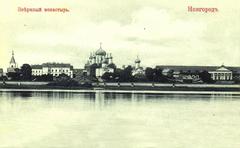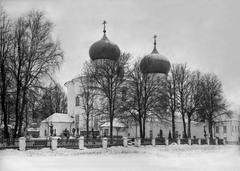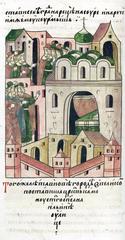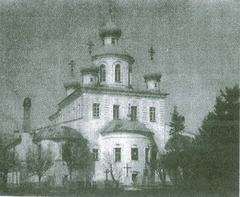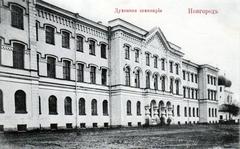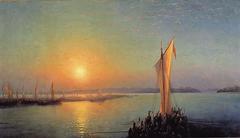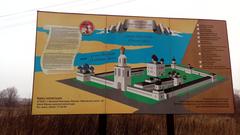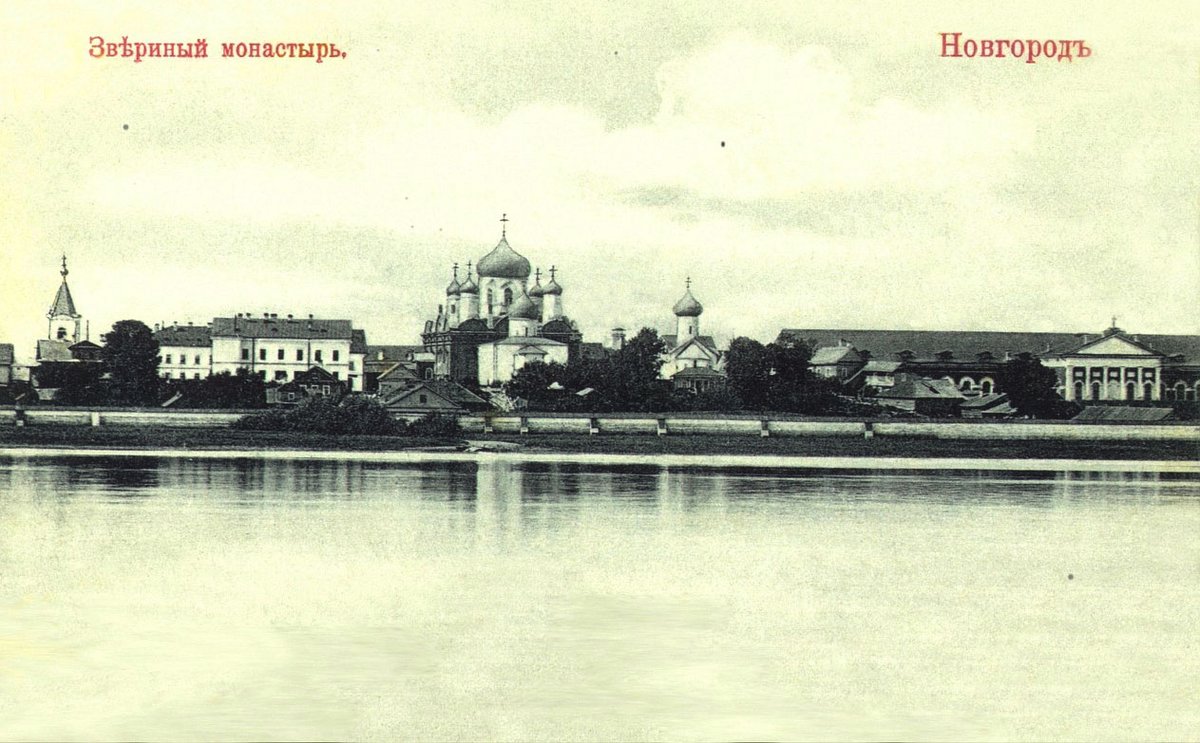
Zverin Monastery Visiting Hours, Tickets, and Historical Guide – Veliky Novgorod
Date: 14/06/2025
Introduction
Nestled along the left bank of the Volkhov River, the Zverin Monastery is a distinguished landmark in Veliky Novgorod, Russia, celebrated for its deep spiritual roots, architectural heritage, and enduring resilience through centuries of Russian history. As one of the region’s oldest monastic sites—first mentioned in 1148—the monastery offers a captivating window into the Russian Orthodox tradition, medieval artistry, and the city’s vibrant cultural tapestry. Its name, derived from the Russian word for “beast,” hints at the area’s historical role as a royal hunting ground, adding a unique dimension to its story (nz.destinationsae.com; ss.destinationsae.com; pineqone.com; worldheritagesite.org).
Today, Zverin Monastery is both an active spiritual center and a cultural monument within the UNESCO-listed Historic Monuments of Novgorod. Its serene grounds, centuries-old churches, and evocative frescoes invite visitors to explore Russia’s spiritual and artistic legacy.
Historical Overview
Early Origins
The monastery’s foundation is rooted in the 12th century, with the earliest mention of a wooden Church of the Intercession in 1148. Despite its destruction by lightning, the site’s religious significance endured. The word “Zverin” references the medieval “Zverinets,” or animal enclosure, once part of the area (ss.destinationsae.com).
Medieval Development
Over the next centuries, the monastery expanded, with key constructions including the Church of the Intercession (1399, rebuilt multiple times) and the Church of St. Simeon the God-Receiver (1467), the latter commemorating plague victims. The ensemble reflects evolving Novgorodian styles and the resilience of the Orthodox community through hardships such as Swedish occupation and fires (pineqone.com; SpottingHistory).
19th–20th Century Transformations
The imposing Cathedral of the Intercession (Pokrovsky Cathedral), built from 1899 to 1901, became the monastery’s centerpiece, blending traditional Russian Orthodox motifs with late imperial influences. The Soviet era brought closure and repurposing, but the cathedral was returned to the Orthodox Church in 1989, heralding a period of revival and restoration (ss.destinationsae.com).
Architectural and Artistic Highlights
Cathedral of the Intercession (Pokrovsky Cathedral)
- Built: 1899–1901
- Features: Five domes, ornate iconostasis, and frescoes representing the pinnacle of late 19th-century Russian Orthodox architecture (SpottingHistory; Pineqone).
Church of St. Simeon the God-Receiver
- Built: 1467
- Notable for: Commemorating the end of a plague; retains medieval stonework and Novgorodian architectural traits (Wikipedia; SpottingHistory).
Church of the Intercession (Pokrovskaya Church)
- Origins: 1148 (wooden), rebuilt in stone (1399, 17th century, and later)
- Significance: Survived repeated destruction, featuring layered architectural details and ancient fresco fragments (SpottingHistory).
Monastic Walls and Grounds
- Walls built between 1840–1860
- Layout: Traditional monastic organization, with sacred and functional buildings amidst tranquil gardens (Wikipedia).
Frescoes and Icons
- Fresco fragments and gilded iconostasis in the Cathedral of the Intercession offer a glimpse into medieval Novgorodian artistry (Pineqone).
Religious and Cultural Significance
Zverin Monastery has functioned as a convent, spiritual retreat, and center for religious education and manuscript production. Pilgrims continue to venerate its relics and icons, especially during major feast days such as the Intercession of the Theotokos. The monastery’s revival since 1989 underscores the enduring significance of Orthodox faith in Novgorod (ss.destinationsae.com).
Female monasticism has played a vital role in preserving traditions and offering social services, making the monastery an important source of spiritual and cultural continuity (ss.destinationsae.com).
Visitor Information
Location & Accessibility
- Address: 18 Bredova-Zverinaya Street, Veliky Novgorod, Russia
- Getting There: About 1.5 km north of the Novgorod Kremlin; accessible by foot (15–20 min), taxi, or public transport (trek.zone; visitnovgorod.com).
Opening Hours
- Standard Hours: 9:00 AM – 6:00 PM daily
- Note: Schedule may vary during religious holidays or special events. Check official sources before your visit (soborpokrova.ru).
Tickets & Admission
- Entry: Free to monastery grounds
- Cathedral/exhibitions: Approx. 200 RUB for adults; discounts for students/seniors
- Guided Tours: Available in Russian and English, typically 1–1.5 hours; advance booking recommended (soborpokrova.ru).
Facilities
- Accessibility: Ramps at main entrances, limited parking (including disabled spots), restrooms, and souvenir shop
- Amenities: Modest gift shop with religious items and literature
Visitor Etiquette
- Dress Modestly: Women should cover heads and wear skirts/dresses; men should avoid shorts and sleeveless shirts
- Photography: Permitted outdoors; often restricted inside churches, especially during services
- Silence & Respect: Maintain quiet, especially during liturgies; follow posted instructions
Suggested Itinerary & Nearby Attractions
- Combine with: Novgorod Kremlin, St. Sophia Cathedral, Museum of Wooden Architecture, Yaroslav’s Court, and scenic walks along the Volkhov River (Restgeo; Audiala)
- Best Visiting Time: Late spring to early autumn for pleasant weather and gardens in bloom
Frequently Asked Questions (FAQ)
Q: What are the Zverin Monastery visiting hours?
A: Daily from 9:00 AM to 6:00 PM. Confirm before your visit for possible changes.
Q: Is there an admission fee?
A: Entry is free; some exhibitions/tours require a ticket (approx. 200 RUB).
Q: Are guided tours available in English?
A: Yes, especially during the tourist season. Book in advance (soborpokrova.ru).
Q: Is the monastery accessible for visitors with disabilities?
A: The grounds are mostly flat; some entrances have steps, but ramps are available at main buildings.
Q: Can I take photos inside the churches?
A: Usually not during services or near fragile artworks; always ask permission.
Maps & Visuals
Recommendations and Key Points
- Plan ahead: Consult soborpokrova.ru or local tourism offices for the latest updates
- Dress appropriately: Respect local customs and religious practices
- Combine attractions: Maximize your visit by exploring the surrounding historic sites of Veliky Novgorod
- Support preservation: Consider making a donation to help maintain this historic gem
Sources and Further Reading
- Main Monasteries of the Novgorod Region, 2025, DestinationsAE
- Zverin Monastery in Veliky Novgorod: History, Spiritual Significance & Visitor Guide, 2025, DestinationsAE
- Zverin Monastery Attractions, 2025, Pineqone
- Historic Monuments of Novgorod – UNESCO, 2025, World Heritage Site
- Zverin Monastery – Trek.Zone, 2025
- Official Zverin Monastery Website, 2025
